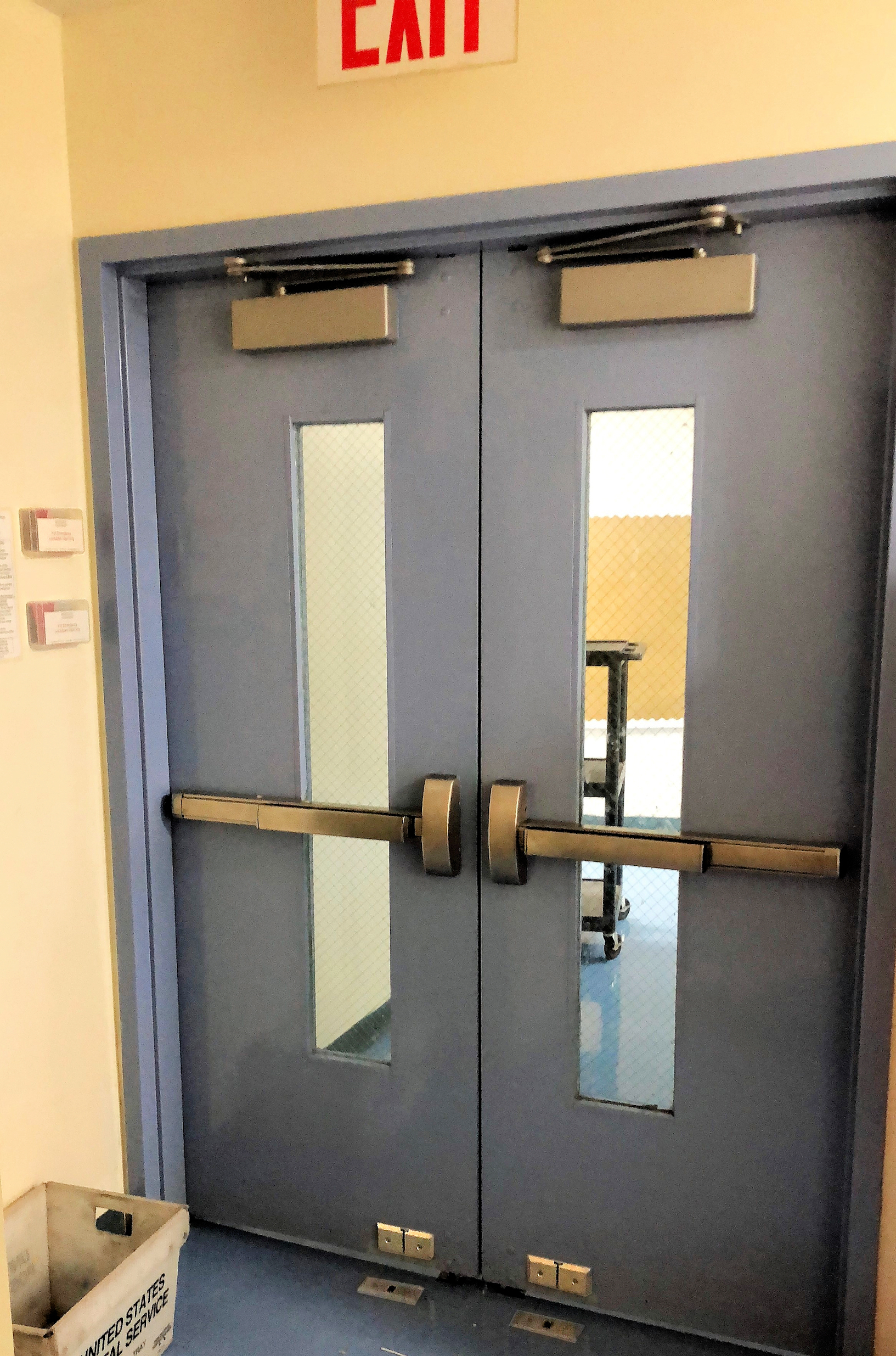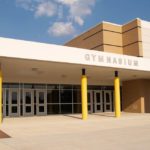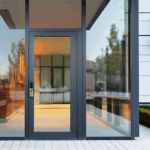Do you see any problems with today’s Wordless Wednesday photo? Each of the plastic boxes mounted on the wall to the left contains an L-shaped piece that goes into the slot on the face of the door, and the hole in the floor, to keep the door from being opened. While this might seem like an easy way to secure these doors, I have some concerns:
- The model codes do not allow this type of device on these doors. It’s possible that the local codes in this jurisdiction have been modified to allow them, but that doesn’t necessarily release the facility from liability for unintended consequences that could occur.
- The device does not meet the requirements of the ADA Standards for Accessible Design, the standards that are used to ensure compliance with the Americans With Disabilities Act – a federal law.
- If these doors (or other doors with this application) are fire doors, all components must be listed to UL 10C / NFPA 252 which ensures that they will perform properly during a fire. Most of the barricade products have not been tested or certified.
- What prevents an unauthorized person from installing these devices and deterring egress for the occupants of the room? Or preventing an authorized person from entering to help?
- Aside from the potential safety issues, how effective will this method be when it comes to security? Is there a maintenance plan in place to make sure that the holes in the floor do not become filled with debris?
Any other concerns?
You need to login or register to bookmark/favorite this content.






Besides the obvious life safety issues, gaining entrance might be easy. Is the glazing SchoolGuard or ballistic-rated glazing? If not – and the threat has a gun – gaining entrance by shooting the glazing is as simple as bang-bang. Even if the threat isn’t a shooter – breaking the glazing and reaching through the opening to pull out the pin is a possibility.
If the doors are Fire Rated, there is too much glass in the door, I am not sure of the code in the USA, but in Canada, this size of Glass would not be allowed on any Fire Rated Door. This door looks like it is part of a Fire Wall, which in Canada is only allowed to have 110 Sq Inches of Glass in the door unless it is Fire-Lite Glass, this looks like GPW glass, the other issue I see, the door Closers are mounted too far to the center of the doors, based on the Picture, they look like either LCN 4040 or 4024 Closers, which not be more than 8″ from the hinge edge of the door, otherwise, the doors will not open to 90 degrees… which in itself is a major safety issue. Next, the doors are too high off the floor, this is probably why they had the extra locking devices made for the bottom of the doors, as the bottom Locking Pins for the Panic Bars cannot reach the floor to lock the bottom of the doors.
These added temporary door locking devices are from NIGHTLOCK. Model Lockdown1.
Firstly, unintended consequences could come with any thing you can dream up.
Cellphones, texting and driving.
Pencils, who hasn’t been stabbed with a pencil?
Hammers, woodshop class has enough for a mob, and tight grasping is necessary.
ADA Standards.
The two plastic boxes could be installed a liitle lower, between 36 – 44″ may be better.
The plastic boxes meet ADA Standards,
but the (Non Fixed Parts) inside are exempt. Much like a fire extinguisher. There are at least 3 exceptions in ADA which exclude this product.
Also, the pictured devices may be in an exempt religious entity’s building.
Fire Door Rating.
Nightlock Lockdown devices are Listed and Labeled To: UL 10B, UL 10C, NFPA 252, and CAN/ULC S104.
You are correct that most barricade products are not tested and certified.
It is possible that an unauthorized person may engage a barricade, or even engage any standard traditional lockset with a thumb turn, to keep out an intruder or authority. Why are only barricades singled out to have unintended consequences? Any authorized person will have access to the keys or other releasing credential.
All facilities using this type of emergency lockdown equipment is of course required to perform in staff training and practice drills and do regular maintenance and cleaning to ensure workability.
It is unfair that “BIG HARDWARE” goes to such lengths to discredit a reputable competitor.
Most Barricade manufacturers are genuine hardware industry professionals. Their products are engineered, patented and marketed.
Yet, they are discriminated against, denied membership in some trade associations, and denied marketing and advertising opportunities in some trade publications and tradeshows.
NIGHTLOCK products are installed in approx. 4000 school districts nationwide, universities, countless government facilities, churches, court houses, medical facilities, police and fire facilities, countless residential homes.
Other manufacturers also have similar popularity.
Barricade products provide solutions to standard hardware limitations. For instance when the door glass is attacked, and the door is unlatched by reaching into the room.
The famously over used, “No locked classroom door has ever been breached by an Active Shooter”, is so not true. (See the Red Lake Minnesota mass shooting) for one.
Glass treatment such as Ballistic film is awesome, but is usually very costly.
It’s nice to know the Codes and Laws are catching up with some appropriate changes.
We are all in this together.
Stay safe everyone.
It’s true that there could be unintended consequences any time, anywhere, but I think avoiding the obvious ones would be prudent – especially where children are present. I have kids and I know A LOT of kids. I grew up with 4 brothers. I can easily imagine a kid installing a barricade device on a door as a prank, or to secure the classroom to prevent school staff or first responders from entering. In a school shooting near Denver, the shooter – a student – removed the magnetic strip from the strike to allow the door to latch and lock, so it could not be opened from the outside. There is more information about that incident here: https://idighardware.com/2019/10/classroom-door-magnets/.
It’s true that “non-fixed parts” (like keys) are not required to comply with the ADA. It’s also true that many barricade devices do not meet the intent of the ADA – they may require tight grasping, tight pinching, or twisting of the wrist to operate, or they may be mounted outside of the allowable range. The bottom line is that people with certain types of disabilities would not be able to install or remove these devices. And while a religious facility may be exempt from the ADA requirements, they are not exempt from the adopted codes and referenced standards.
The door at Red Lake High School was not breached through the lock – the glass was broken and the shooter reached through to turn the lever and retract the latch. There is glazing and film available to address this problem, and in new schools, the sidelights and vision lights can be located on the opposite side of the door – away from the hardware. Traditional locks work, and can easily be unlocked from the outside with a key or electronic credential, without having to search for another way in. John Montes, Emergency Services Specialist at the National Fire Protection Agency (NFPA), had a strong opinion on this when he was a panelist on a webinar in December of 2019: “One of the things that we have to consider in these scenarios is that we’re not just planning for an active assailant incident. We’re not just planning for a bad guy coming into a building. We have to think about all emergencies, the broad spectrum of emergencies. I love this statistic…in Massachusetts there were zero school shooters last year – zero – but there were 336 school fires. Now, because the codes have been very effective at keeping people safe in a fire scenario in schools, and they’ve worked – as a matter of fact, the last time someone died in a school fire was 1958. That doesn’t mean we need to sacrifice that level of safety that we’ve achieved in preparedness and prevention for fires, for other scenarios. What we have to do is find balance and make things work all together, and it’s a very rapidly-evolving thing. The best advice I always say is to follow what the current codes say, because the current codes apply the most recent science to the codes.” [John goes on to discuss the unintended consequences of barricade devices and the potential for entrapment, and at 21:55 he is asked about the use of barricade devices vs. barricading with furniture.] You can listen to the full webinar here: https://idighardware.com/2019/12/door-security-and-safety-continuing-the-conversation-video/
I have devoted most of my 35-year career to life safety, fire protection, and accessibility with regard to door openings. I am not at all afraid of good competition, and I don’t use my influence to negatively impact other manufacturers or products. But when I see a product that is not code-compliant, I will say so. I can not in good conscience sit back and allow schools to choose a security device that may not allow free egress in an emergency, without alerting them to the potential downside. Sadly, I expect that the day will come when a barricade device will be used by an unauthorized person and will result in fatalities. In the meantime (and beyond), I will continue to educate people about the codes and standards that protect building occupants.
– Lori
Thank you Lori! “Any authorized user would have access to keys or other releasing credential.” Yes this is true with traditional hardware, not with a barricade device like this though. Red Lake High School door breach could have happened with a barricade device such as the one referenced. How many classrooms already have Classroom function locks on them? I would hedge a bet that most do. To change to Classroom Intruder Function is NOT that expensive especially on many mortise locks that essentially just need an additional cylinder on the inside….. If you are going to have the locking device (barricade device referenced) next to the door, why not have a key that does the same thing next to the door? Key the interior cylinder different for every classroom with the same master keys operating those locks and you have the same solution except it is a better solution in that the teacher can be carrying a key and gain access in the case of a rogue student locking the door.
Joe, what can you design for authorized access on your product? There needs to be a “tool” available from the MFG to allow First Responder Access without prying the door open\significant destruction and time delay. Maybe a specially designed “prybar” that could be inserted under the door to lift and remove the device? Some simple modifications could be made to accept a tool like this. IE: hole in the side of the auxiliary piece for a tool to slip into, some kind of protrusion on each side so that this tool could be inserted under the door quickly and the position be found even in a smokey situation. Feel free to reach out directly to me. I love well engineered products and tweaks that can be done to make good products even better.
Thanks for your comment, Wes. There is a method for releasing this from the outside – it requires a special tool that slips under the door and pushes the barricade device up and out of the slot. I’m concerned about whether the tool would be available in an emergency and whether it could be used effectively on doors with various clearances, by people who may have never used it before. There are other code requirements that these barricade devices do not meet, so I would prefer to see a code-compliant lockset that allows free egress and meets the ADA requirements while providing the necessary level of security and reliable access for emergency responders.
– Lori